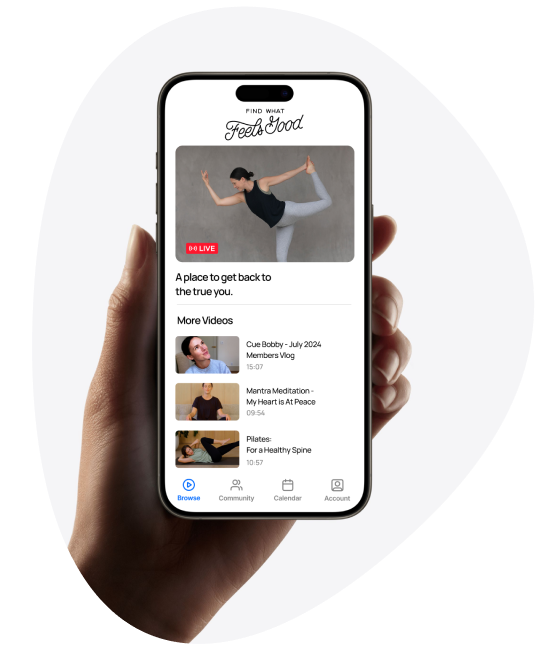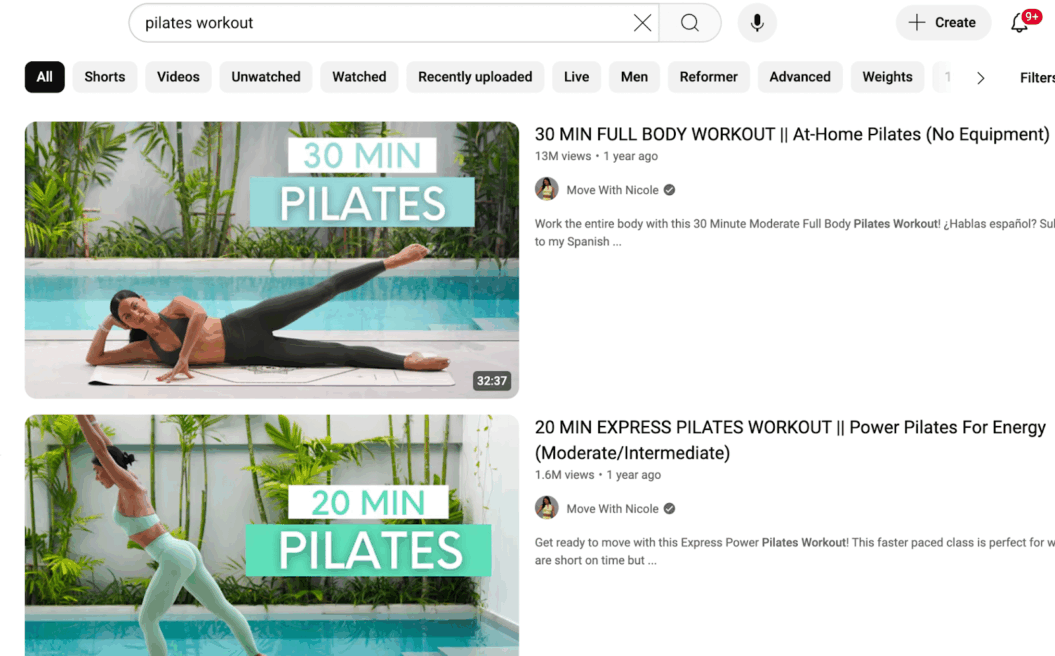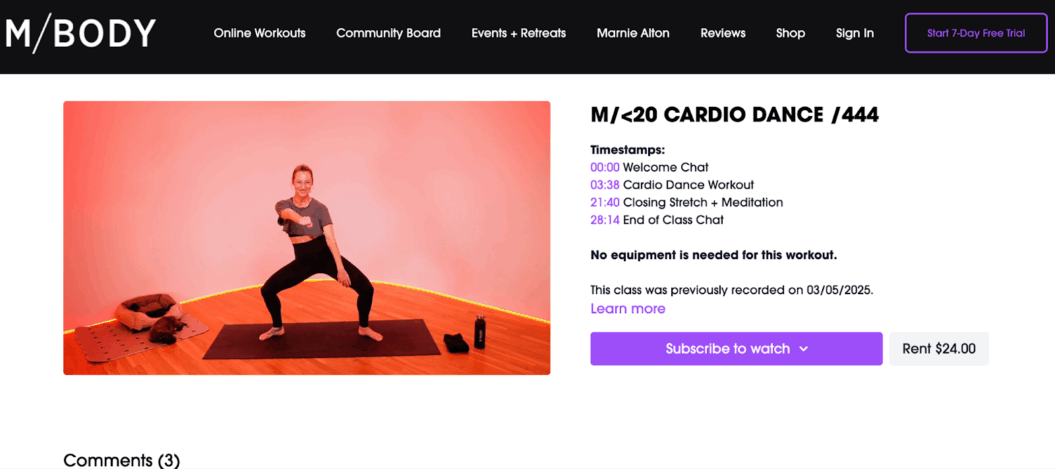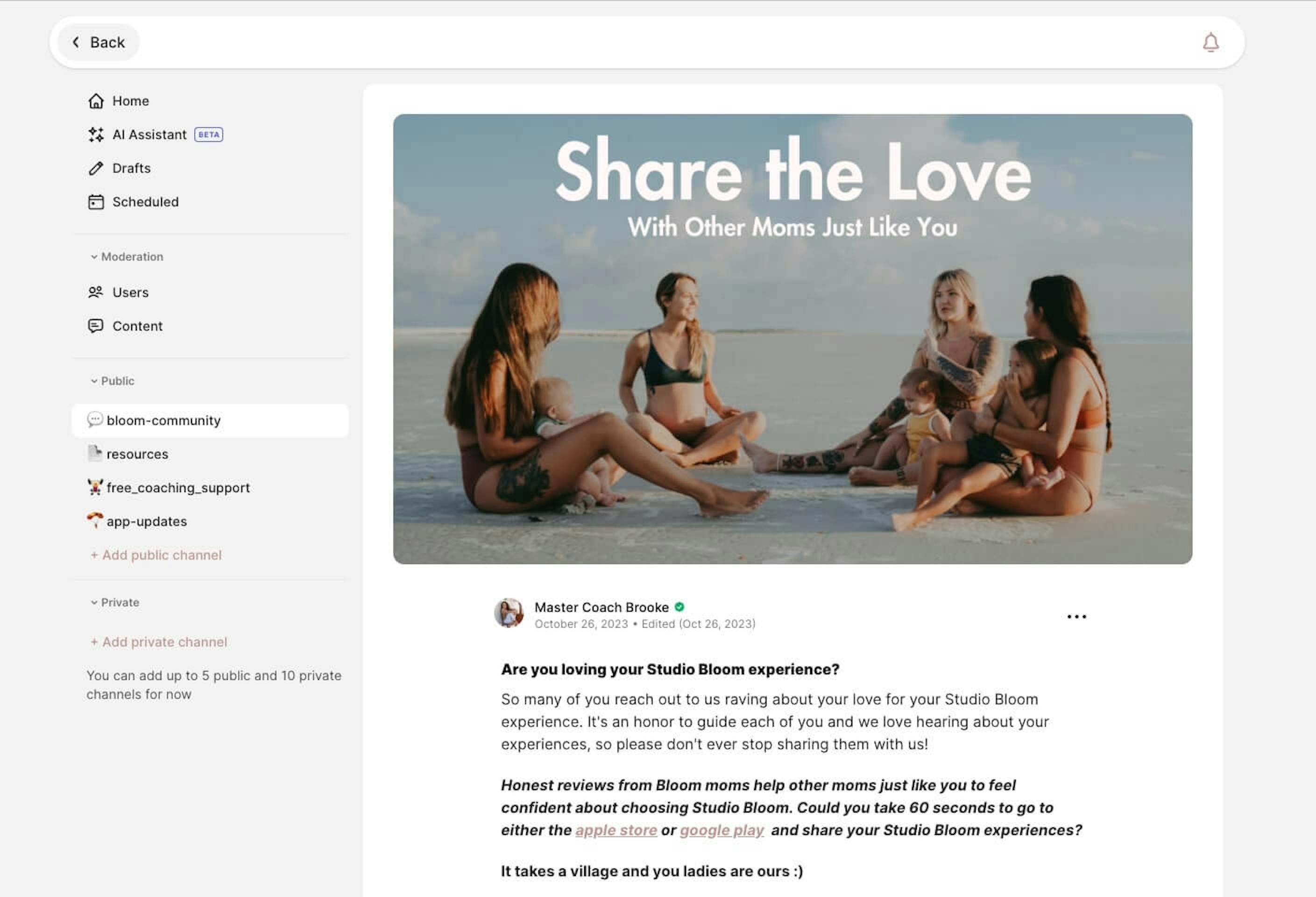While the internet is flooded with articles listing dozens of ways to monetize fitness videos, most lack the practical guidance needed for actual implementation.
At Uscreen, our expertise in video monetization allows us to cut through the noise and identify the specific strategies that work at each stage of your content journey:
- Beginner: Monetizing fitness videos on YouTube or Instagram. Best for beginner fitness video creators who want to learn about content monetization, marketing, and community engagement.
- Developing: Sell single fitness videos. Best for creators who have a small audience but want to earn more than they can with ad revenue on YouTube or Instagram.
- Established: Selling a fitness course or program. Best for creators with more substantial content and audience engagement
- Advanced: Launching a Fitness Membership. Best for fitness creators with an engaged audience who want to offer maximum value and generate as much stable revenue as possible.
This guide presents four proven monetization paths – from leveraging social media to building subscription-based communities – with clear guidance on which approach best fits your current situation.
Your $0 – $100k Blueprint
Launch a fitness membership confidently with this step-by-step blueprint. Get timelines, templates, and more inside.

1. Monetizing fitness videos on YouTube or Instagram
Best for beginner fitness video creators who want to learn about content creation, marketing, and community engagement.
This is where many fitness video creators get their start, and there are lots of advantages to building your fitness brand on social media. There’s a huge potential audience, it’s free to get started, and you can experiment with your approach to find the right combination of factors that works for you.

One big advantage of getting started with fitness content on YouTube or Instagram is that you don’t need an audience – you’re here to build one. So if you’re just getting started, you can jump right in and start earning as soon as you meet the platform requirements (you can read more about that in our guides to YouTube monetization and Instagram monetization).
Of course, there are some drawbacks to monetizing on social media. Your reach is largely determined by search algorithms that change frequently. Some creators see their viewership drop dramatically after a new algorithm update. Ad revenue is also notoriously unpredictable and dependent on many factors outside of your control. And, in the worst cases, your videos or entire channel can be demonetized – sometimes even by accident.
We asked Sasha Alex Morgan what’s been most important in her success in monetizing her videos and creating Sasha Alex Studio:
Showing up consistently on Instagram with daily posts and stories and building a community there has been key to my success. Tracking what content is both engaging best on Instagram and translating to the most sign ups to my membership and then continuously leaning into that.
She shares her advice for getting started with monetizing your videos: to build a community who trust you and see you as an authority in the industry but also someone who they relate to is key. Start with the minimum viable product and let go of trying to create ‘perfect’ content.
Pros
- Ad revenue: If your fitness videos get a lot of views, you can make thousands of dollars in ad revenue. You also don’t have to do much – just get content in front of your audience and let the platform do the rest.
- Other monetization avenues: Brand sponsorships, YouTube channel memberships, affiliate marketing, and other strategies can boost your earnings if you primarily post on social media.
- Great for growing an audience: You don’t need any followers at all to get started, but you can amass a huge following if you’re diligent about regularly posting high-quality content.
- Lets you experiment: Because you can start for free and you don’t have a huge audience that has specific expectations for your content, you get to experiment with your brand and content to find what resonates with the people you’re trying to reach.
The flexibility and huge potential audience of social media were a boon to Yoga with Adriene, a hugely popular YouTube channel where Adriene Mishler shares free yoga videos. Mishler started the channel in 2012, and has built a following of over 13 million subscribers.

Since creating that massive following, Mishler and her business partner have launched Find What Feels Good, a premium yoga streaming service that includes mobile and smart TV apps as well as built-in community features. But YouTube is still an important part of Find What Feels Good’s business model: not only does it still earn ad revenue, but it’s a great marketing tool for getting people to the streaming service.
Cons
- Requires volume: Only the most successful creators get enough subscribers and views to earn significant money. On average, 1,000 ad views will pay between $3 and $5. It can take a while to build up an audience that provides consistent revenue.
- Social algorithms: Your reach is determined largely by social media networks’ algorithms, and that can result in unpredictable revenue.
2. Selling single fitness videos
Best for creators who have a small growing audience but want to earn more than they can with ad revenue on YouTube or Instagram.
Social media is great for building an audience, but if you want more stable earnings – and to earn more than a few cents at a time – selling access to your videos is a logical next step. You get more control over your earnings, you reduce the risks of algorithm changes and demonetization, and you own your audience.
One of the big advantages of selling your own videos, especially on a fitness streaming platform, is that you can use more flexible monetization methods. For example, you might sell access to a particular workout video for $10-20, but also allow people to rent it for 24 hours for just $2.
We’ll discuss even more flexible monetization methods below, but this is a solid first step toward revenue freedom.
These increased prices do require that you shift your business model, though. You’ll need to spend more time marketing your fitness videos unless you still have an active social media following that you can get to your website. And you’ll need some way to encourage users to keep buying from you.
The simplest way to do that is to keep publishing new content that they want – but you’ll need to make sure that they know about it and are convinced to spend.
Pros
- Higher value sales: Instead of getting $10 for a few thousand views, you’re now getting a set amount of money for each video.
- Offers multiple monetization pathways: Having more revenue streams is great, and selling your videos means you can earn from sales, rentals, and ad revenue if you decide to keep your social pages going.
- Can be combined with other monetization methods: We’ll dive into courses and memberships below, but combining them with selling single videos gives you a lot of flexibility and more ways to earn.
M/BODY began as a brick-and-mortar barre fitness studio in 2014, but transitioned to a fully online platform in 2020. Founder Marnie Alton continues growing the business, teaching over 1,200 members and earning $40,000 in monthly revenue.

One of the ways that M/BODY generates that revenue is by offering not just subscriptions, but also access to single videos. Non-members can rent one workout to try out the service or if they get a great recommendation from a friend.
This kind of flexible monetization goes a long way toward building a stable source of revenue.
Cons
- Small-ticket sales: While you’ll earn more per video than you might on social media (unless you have a huge following), we’re still probably talking about $10 or $20 per video, which requires a significant amount of volume to make a living.
- Requires a significant amount of marketing: When you’re focused on selling single fitness videos, you’ll need a large number of people to see them if you’re going to make enough sales.
- Hard to generate loyalty: While you might have fans that buy more than one of your videos – even all of them – it’s hard to generate a real sense of loyalty when you’re selling one video at a time.
Lena from Starlight Online Movement Studio shares her advice on getting started with fitness video monetization:
I would suggest to really think about what’s different about your approach and offer. The biggest problem people have is not that there aren’t enough classes to choose from. More so, they struggle to show up consistently for a variety of reasons. If you can figure out how to have your classes solve at least one of the consistency issues for people, it’s huge.
3. Turning multiple videos into fitness program courses
Best for creators with more substantial content and audience engagement.
If you have videos that work together in a sequence to teach something, you might be thinking about creating a video course. It’s a great evolution of the single-video strategy above: you sell a whole fitness program, provide more value, and have people sticking around to watch your content longer.
This strategy has worked for countless fitness creators. There are courses that teach specific fitness skills, target particular types of fitness gains, or help specific groups of clients.
Some are just a few videos long, while others could include dozens of videos – it all depends on the value you’re trying to provide and what your audience is looking for. This flexibility is a huge advantage of selling courses.
We asked Lena from Starlight Online Movement Studio what’s been most important in her success in monetizing her videos:
Bringing in the human-centred approach, normally experienced in in-person classes, to the video space. Ensuring that despite the online delivery, people are still heard, their questions are being answered and requests are being met.
But courses have some of the same problems as selling individual videos: you’ll make more money per purchase, but you’ll still deal with inconsistent revenue. You’ll need a steady influx of new viewers to make up for that. And unless you release courses regularly, the lifetime value of each customer isn’t likely to be very high.
Pros
- Higher-ticket sales: Depending on the type of course you’re offering, you could sell a single set of fitness videos for hundreds of dollars. Not every course can command this kind of price, but the point is that you’ll earn significantly more per sale than you would selling a single video.
- Provide more value: It’s easier to convince someone of the value of an entire course of videos than it is a single video – and that makes selling easier.
- Offer many monetization pathways: In addition to selling your courses, you can monetize your videos individually by selling or renting access to them. Higher-ticket items like courses may also be more viable for promotional tactics like limited-time offers, referral bonuses, or discounts.
Backbody Project is a great example of the benefits of offering courses. With programs like 21 Days to Make a Habit, Backbody Prenatal, and BBP for Runners, the online fitness program offers a range of courses that walk users through specific progressions that address their goals.
Fans of Backbody can rent courses (most for $20 to $30) or get access to all of the site’s content with a subscription. Courses range from 7 days to 21 days, with a single workout each day. It’s a great way to show potential members the value of the site’s content without requiring that they sign up for a full membership.
Cons
- Still requires steady influx: If your focus is on selling courses, you’ll still need a lot of people coming to your site, which may require social media or another form of marketing.
- May be difficult to get repeat buyers: Depending on how often you release courses, you may find it difficult to turn buyers into repeat customers.
4. Creating a fitness membership site
Best for fitness creators with an engaged audience who want to offer maximum value and generate as much stable revenue as possible.
If you have an engaged audience and want a stable stream of revenue in the online fitness world, there’s no better way than creating a fitness membership site. When members value both your content and the membership community, you have a winning combination.
Membership sites have a lot of advantages, but the fact that members have an engaging community to keep them coming back is first among them – and online community is one of the online fitness trends to pay attention to in 2025.
Among Uscreen customers, those with an active community see half the churn of those without one. Combine that with monthly or annual subscription payments, and you have the best way for fitness creators to make a living online.
Of course, there are things you need to make this work. You’ll need enough content to launch a subscription service. You’ll need enough of an audience that it’ll cover your costs to launch this sort of site. It also helps if you have some experience with selling courses or building a community.
Sasha Alex Morgan shares how community has been central to her monetization strategy:
It has been really key for establishing trusting relationships with my clients, for helping them to feel seen and supported in their journey on the membership by one another and me. It is also really important for me to understand them and their pain points so I can create the best suited content for their needs and speak more directly to them in my copy and brand tone.
Pros
- Most predictable revenue: Monthly (or, even better, annual) subscriptions give you a very clear idea of how much revenue you can expect in a given timeframe.
- Highest chance of retention: Building a community that provides value is the best way to keep users coming back month after month and year after year.
- Tiered subscriptions offer flexibility: You might offer access to all of your video content for one price, a selection of it for another price, and only offer access to your community at another price point. This helps prospective members find what works for them.
- Better monetizes audiences: Did you build a big following on social media? Or accrue a large email list because of your courses? You can easily turn that into memberships.
Community is a big part of why The Bloom Method has been so successful. This Pre- and Postnatal fitness community offers workouts, courses, coaching, apps, and an active community that members can engage in.

Brooke Cates, founder of The Bloom Method, says that Uscreen’s community features are among her favorites. With public and private channels, access controls, and moderation, she can ensure that interactions among her community members make the Bloom community a better place.
Cons
- Best for creators with an audience: While you may want to skip right to this step for monetizing your fitness videos, it’s better to build an audience on social media or through another method before you launch your membership site.
- Platforms have a learning curve: Platforms dedicated to building membership sites – like Uscreen – are more complex than social media platforms or tools you might use to sell single videos. You’ll need to spend a bit of time getting used to using the site building, marketing, and analytics tools.
- May require a steady stream of new content: Depending on how you’re providing value to your audience, you may need to publish new content regularly. If you’re committed to monetizing fitness videos, this isn’t likely to be a problem, but it’s something to consider.
We’ll leave you with one last expert insight from Lena about why building a strong community is so important, and how it makes you stand out from the other more generic online fitness brands out there:
I think genuinely trying to get to know people who join your classes is crucial – both for your personal satisfaction and for being able to tailor to experience to them. The online spaces are progressively getting more and more automated. In that case, offering a personalised approach goes a long way in terms of helping folks make a real difference to their lives.
Choose the right way to monetize your fitness videos
The four methods of fitness video monetization above all have pros and cons, but what’s most important is understanding where you are in your journey.
Are you just getting started? Social media is probably the best bet. Once you have a decent following, you might start selling single videos or courses. After a while, you’ll have a larger audience and a really good idea of how you can provide enough value in your fitness videos that viewers are willing to open their wallets. And, once you have a solid process in place and an audience that wants to engage, it’s time for a membership site and growing your online fitness community.
Of course, these aren’t hard and fast rules. You can build a membership site as your first step if you’re confident that your marketing skills will get you enough members. Or you could stay on social media forever if you prefer that format.
No matter which method of fitness video monetization you decide to pursue, the most crucial step is getting started. So grab your camera, film your first videos, and get them out into the world!








